For many, the idea of cooking rice perfectly can feel like a culinary challenge, often leading to sticky messes or undercooked grains. Yet, a simple, often overlooked kitchen tool offers a consistent solution: the microwave rice cooker. This innovative appliance is transforming how individuals approach meal preparation, promising fluffy rice and grains with remarkable ease and speed.
What Exactly is a Microwave Rice Cooker?
A microwave rice cooker is a specialized container, typically crafted from durable plastic or glass. Meticulously designed for cooking rice and other grains efficiently within a microwave oven. Its ingenuity lies in its all-in-one functionality, allowing for the measuring, washing, cooking, and serving of perfectly fluffy rice and grains in minutes. Eliminating the need for multiple pots, pans, colanders, and strainers.
The core of its operation lies in how it interacts with microwave technology. Microwaves generate electromagnetic waves that cause water molecules within the food to vibrate, producing heat. This process ensures that cooking occurs from all sides, a distinct advantage over traditional stovetop methods which can often heat unevenly. Leading to scorched or undercooked sections of rice. The design of these cookers typically incorporates an inner and an outer lid system, featuring strategically placed vents. These vents are crucial for managing steam and preventing messy boil-overs. Ensuring the rice cooks thoroughly without drying out or becoming overly mushy. Some advanced models even include a pressure chamber plate designed to collect any overflow and return it to the cooking pot. Further enhancing the mess-free cooking experience.
While its name highlights rice, This container is surprisingly versatile.
Many models are capable of preparing other popular grains such as polenta, quinoa, and couscous. Some even come equipped with dedicated steamer baskets, making it fast and easy to steam vegetables or even cook pasta within the same unit. This multi-purpose capability underscores a significant benefit: the microwave rice cooker is more than just a single-task gadget. It is a system that fundamentally simplifies and streamlines the entire cooking workflow for staple grains. By consolidating multiple steps and pieces of equipment into one compact unit. It drastically reduces both active cooking time and post-meal cleanup.

This comprehensive simplification of the cooking process makes it a game-changer for busy individuals or those with limited kitchen space. Transforming what could be a multi-step chore into a remarkably contained and effortless operation. This positions the microwave rice cooker as an essential tool for modern, efficient home cooking, appealing to those who value practical, streamlined solutions. It is about optimizing the entire kitchen experience, not just cooking rice. The way microwave cooking inherently heats from all sides, vibrating water molecules to create heat. Directly addresses a common frustration with stovetop rice. Inconsistent cooking that results in burnt bottoms or undercooked grains.
This is a crucial functional advantage, demonstrating that microwave cooking. For this specific application, can offer a superior method for achieving consistent results. This perspective helps to reframe the perception of microwave cooking. Elevating it from merely a reheating tool to a legitimate and often more effective method for grains. Thereby expanding its perceived utility in the modern kitchen.
The Perks of Popping Rice in the Microwave: Pros Unpacked
The compelling advantages of microwave rice cookers often lead users to consider them an indispensable kitchen tool. Transforming meal preparation from a chore into an effortless routine.
Speed & Convenience: Your Time-Saving Kitchen Ally
Microwave rice cookers are champions of speed. Significantly cutting down cooking time—often to about half of what it takes on the stovetop. For instance, white rice can be ready in a remarkably short 13-17 minutes. Depending on the microwave’s wattage and the specific cooker. This rapid cooking capability makes them an ideal solution for individuals with busy lifestyles.
Beyond just speed, these cookers offer unparalleled convenience through their “set it and forget it” nature. This means minimal active supervision is required. Freeing up time to focus on preparing other components of a meal or simply enjoying a well-deserved break. There is no need to constantly monitor, stir, or worry about the rice sticking to the bottom of a pan, a common pain point with traditional methods. This benefit extends beyond simple time-saving. It addresses the burden associated with traditional rice cooking methods. Which often tie up a stovetop burner and demand continuous attention.
By liberating both a cooking surface and the cook’s mental and physical resources. The microwave rice cooker allows for more efficient multitasking in the kitchen. This means users can simultaneously prepare other dishes, attend to other household tasks, or simply relax. Significantly improving the overall cooking experience and reducing the stress often associated with meal preparation. It transforms cooking from a dedicated, time-consuming chore into a more flexible and integrated part of a busy day. Making home cooking more accessible and less daunting for individuals with demanding schedules.
Consistency & Simplicity: Foolproof Fluff Every Time
One of the most lauded benefits of microwave rice cookers is their ability to produce consistently well-cooked, fluffy rice. They are designed to make it “nearly impossible to overcook” the rice, leading to widespread user reports of “perfect rice every time” with “little effort”. This appliance effectively handles the cooking process. Often eliminating the need for the precise temperature adjustments, constant monitoring, or delicate timing that traditional stovetop methods demand. This inherent simplicity makes them remarkably foolproof. A significant advantage for anyone who has struggled to achieve perfect rice consistently using other methods.
This advantage goes beyond mere convenience; it makes the ability to cook perfect rice widely available. It removes the skill barrier that often intimidates novice cooks or those who view rice preparation as a complex culinary art. By making consistent, high-quality results accessible to virtually anyone, regardless of their cooking expertise. It fosters confidence in the kitchen and significantly reduces food waste from botched batches. This shifts the narrative of rice preparation from a challenging task to a reliable, achievable outcome. Potentially encouraging more people to prepare homemade meals and reducing reliance on less healthy pre-packaged or takeout options.
Space-Saving & Portability: Ideal for Any Kitchen Size
Unlike bulky electric rice cookers that demand dedicated counter space, microwave rice cookers are inherently compact and lightweight. This design allows them to be easily stored away in a cupboard when not in use. Freeing up valuable counter real estate. Their portability makes them an excellent choice for a variety of living situations. Including small apartments, student dorm rooms, or even for use in campervans. Furthermore, their light weight and ease of transport make them convenient companions for travel or picnics. As long as a microwave is accessible. This benefit is more than just about fitting into a tight spot; it enables a minimalist approach to kitchen appliances.
For individuals living in constrained spaces or those who prefer a less cluttered kitchen. This appliance offers a practical, multi-functional solution that does not require a permanent footprint. It reduces the need for multiple, specialized pieces of cookware, aligning with a broader lifestyle trend of efficiency, decluttering, and maximizing utility from fewer items. It becomes a key component in creating a highly functional kitchen without overwhelming it with gadgets. Catering effectively to a growing demographic of urban dwellers, students, and digital nomads who prioritize compact, versatile tools.
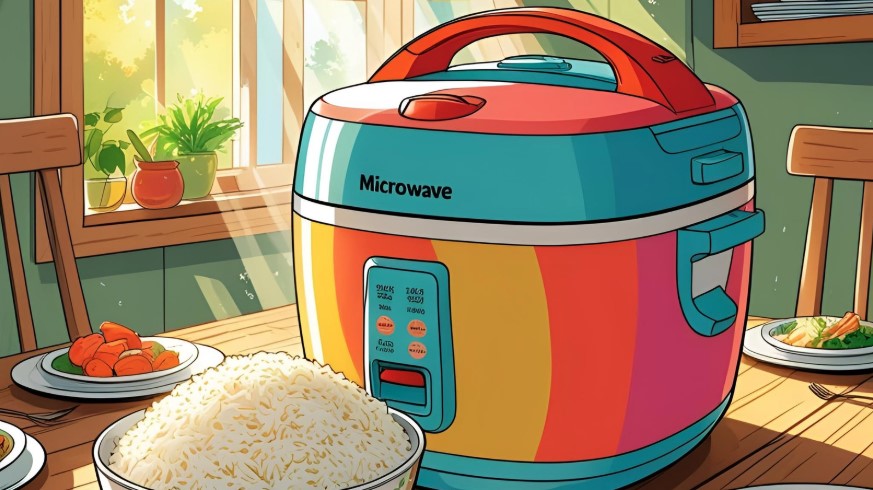
Versatility Beyond Rice: More Than Just Grains
Many microwave rice cooker models are designed with multi-functionality in mind. They often include steamer baskets. Allowing for the effortless steaming of a variety of vegetables (such as potatoes, leafy greens, corn, or carrots), cooking pasta, or preparing other popular grains like polenta, quinoa, and couscous directly within the same unit. This added versatility significantly enhances the cooker’s value, transforming it from a single-purpose gadget into a more comprehensive kitchen tool.
The ability to easily prepare diverse and healthy food components like steamed vegetables and various whole grains in a single. Convenient device can subtly yet significantly encourage healthier eating habits. By simplifying the preparation of nutritious ingredients, it makes it more likely for users to choose homemade, balanced meals over less healthy. Processed alternatives or frequent takeout. This is not just about versatility; it is about facilitating and promoting healthier lifestyle choices by removing common barriers to healthy cooking. For busy individuals, students, or those new to cooking. This multi-functionality can be a powerful motivator to incorporate more fresh, whole foods into their diet, contributing to overall well-being and a more balanced approach to nutrition.
Energy Efficiency & Easy Cleanup: Smart & Spotless Cooking
From an environmental and economic perspective, microwave rice cookers offer notable advantages. Microwaves generally consume less electricity compared to stovetops, which can translate into lower energy bills over time. This makes them a more eco-friendly option for daily cooking. When it comes to post-meal chores. Cleanup is often described as a “snap”. The contained cooking environment means less mess in the kitchen, as water and food stay within the cooker. Furthermore, many models feature non-stick surfaces that prevent rice from adhering, making washing effortless, and a significant number are even dishwasher-safe.
These benefits address the often-overlooked “hidden costs” of cooking. Beyond the obvious time and effort, cooking involves utility expenses and the less tangible burden of post-meal cleanup. The energy efficiency contributes to both financial savings and environmental consciousness, appealing to budget-conscious and eco-aware consumers. Simultaneously, the easy cleanup significantly reduces kitchen chore fatigue, a major deterrent for many home cooks. This means the appliance offers value not just in its primary function but also by mitigating secondary burdens. This positions the microwave rice cooker as a “smart” and responsible choice that aligns with modern consumer values of sustainability, practical living, and overall household efficiency, making it attractive for a wider audience than just those focused on speed.
Are There Any Downsides? The Cons to Consider
While microwave rice cookers offer numerous advantages, it is important to consider their limitations to ensure they align with individual cooking needs and preferences.
Texture Nuances: Achieving Your Ideal Fluff
One of the most frequently cited drawbacks of microwave-cooked rice is that its texture can sometimes be drier or more compact compared to rice prepared using traditional stovetop methods or dedicated, high-end electric rice cookers. Achieving a preferred level of fluffiness and consistency often requires a degree of experimentation, particularly with precise water ratio adjustments and understanding a microwave’s specific wattage. This highlights a fundamental trade-off inherent in the design and function of microwave rice cookers: the unparalleled speed and convenience often come at the expense of achieving the absolute “perfect” or most nuanced texture that a specialized, high-end electric rice cooker or meticulously managed stovetop method might deliver.
This is a critical distinction for users who prioritize culinary perfection, such as specific fluffiness or distinct grain separation, above all else. It implies that while the results are generally good or adequate for many, they might not satisfy the discerning rice connoisseur. This understanding is vital for managing user expectations, helping potential buyers determine if this trade-off aligns with their personal cooking priorities and needs.
Potential for Uneven Cooking: Hot Spots & How to Avoid Them
Despite the microwave’s general ability to cook from all sides, the reality is that hot spots can still form within the cooker, potentially leading to unevenly cooked or even undercooked grains in certain areas. To mitigate this, a commonly recommended tip is to stir the rice halfway through the cooking process. This simple action helps to redistribute heat and moisture, promoting more uniform cooking. While the microwave’s electromagnetic waves theoretically provide uniform heating. The actual cooking outcome can still be influenced by factors beyond the appliance itself. Such as the specific microwave’s power distribution. The cooker’s design, and, crucially, the user’s active participation.
This introduces a user variable into the equation, meaning that while the device simplifies cooking, it is not entirely hands-off for optimal results. It contrasts with the “set-and-forget” ideal often associated with electric rice cookers, implying a slight degree of engagement is beneficial. This underscores the importance of user education and careful adherence to practical tips for maximizing the performance of a microwave rice cooker. It helps users understand that while the appliance is convenient, a little mindful interaction can significantly improve consistency and overall satisfaction.
Material Matters: The Importance of BPA-Free Cookware
A significant concern for many consumers revolves around the materials used in plastic cookware, particularly when heated. There is a risk that certain plastics can release harmful chemicals into food. To ensure health and safety, it is absolutely crucial to select microwave rice cookers explicitly labeled as “microwave-safe” and, more importantly, “BPA-free”. Alternatively, opting for microwave-safe glass or ceramic containers can completely alleviate these concerns. This point goes beyond a simple product specification; it reflects a significant evolution in consumer awareness and product manufacturing driven by health concerns.
The widespread adoption of BPA-free materials in microwave cookware is a direct response to consumer demand for safer products. This is not just a desirable feature; it is a safety standard that has become a key differentiator in the market and a fundamental expectation for informed consumers. It highlights how public health discourse directly influences product design and marketing, empowering consumers to make informed purchasing decisions by prioritizing health-conscious materials. It also signals a broader trend in the housewares market towards transparency and the development of non-toxic, safer alternatives.
Batch Size Limitations: Best for Smaller Servings
While some electric rice cookers are designed to handle very large batches. Such as commercial models cooking up to 60 cups, microwave rice cookers typically have a more limited capacity. They are generally better suited for cooking smaller quantities of rice. Usually ranging from 1 to 4 cups of uncooked rice, which translates to servings for 1-4 people. This inherent limitation might make them less ideal for larger families, individuals who frequently cook for groups, or those engaging in extensive meal prepping.
This limitation is not a flaw but a deliberate design choice that positions the microwave rice cooker as an appliance optimized for specific use cases (individual meals, small households, quick sides) rather than a workhorse appliance for high-volume cooking. Understanding this distinction is crucial for setting accurate user expectations and guiding purchase decisions based on actual household size and cooking frequency. It helps users avoid dissatisfaction by ensuring they select the right tool for their specific scale of use. This helps segment the market for rice cooking solutions, illustrating that different appliances cater to diverse household needs and cooking habits, reinforcing the idea that one size does not fit all in kitchen tools.
Microwave vs. The World: How it Stacks Up Against Stovetop & Electric Cookers
When considering how to cook rice, a variety of methods present themselves, each with distinct advantages and disadvantages. Understanding these differences is key to choosing the optimal approach for individual needs.
Stovetop Cooking: This traditional method offers cooks the most direct control over texture and allows for significant flavor enhancement, such as by cooking rice in broth. However, it demands constant monitoring, can lead to rice sticking to the bottom of the pan, and often results in uneven heating. While it can be the fastest option for small batches if actively supervised, it requires a higher degree of attention and skill.
Electric Rice Cookers: These appliances consistently deliver reliable results and offer convenience with their “set it and forget it” functionality, often featuring automatic keep-warm settings that maintain rice at an ideal serving temperature for hours. High-end models frequently incorporate “fuzzy logic” microprocessors that can compensate for minute differences in rice varieties and age, leading to consistently foolproof results. They are versatile for cooking other grains and steaming, but they do require dedicated counter space and are typically single-function appliances.
Microwave Rice Cookers: This method shines in terms of speed, energy efficiency, and remarkably easy cleanup. It is compact, lightweight, and highly portable. While these appliances offer immense convenience, they can sometimes produce drier rice and less predictable results compared to dedicated electric cookers, often requiring more precise water ratio adjustments and careful wattage calibration.
The following table provides a quick comparison across key criteria:
| Feature/Criteria | Microwave Rice Cooker | Stovetop Method | Electric Rice Cooker |
| Convenience | High (measure, cook, serve in one; minimal monitoring) | Medium (requires active monitoring/stirring) | Very High (set-and-forget; automatic keep-warm) |
| Speed | Fast (13-25 min for white rice) | Medium (approx. 20 min for white rice, active cooking) | Medium-Slow (30-45 min, but hands-off) |
| Consistency | Good (can vary with microwave wattage/water ratio; potential hot spots) | Variable (prone to under/overcooking, sticking, uneven heating) | Excellent (designed for perfect results; high-end models use “fuzzy logic”) |
| Space/Storage | Compact, portable, easy to store when not in use | Minimal (just a pot); no dedicated appliance space | Takes up dedicated counter space; typically single-function |
| Cleanup | Very Easy (often dishwasher-safe; non-stick; contained mess prevents stovetop spills) | Medium (pots can stick; boil-overs create stovetop mess) | Easy (non-stick inner pot; removable parts) |
| Versatility | Good (rice, grains, steaming veggies/pasta) | High (can cook virtually anything in a pot) | High (rice, various grains, steaming; some models have multi-cooker functions) |
| Energy Efficiency | High (uses less electricity than stovetop) | Medium (burner use) | Medium (dedicated electric appliance) |
| Cost | Low (typically under $30) | Very Low (if a pot is already owned) | Medium to High (from $20 for basic to $300+ for advanced models) |
| Best For | Individuals, small households, dorms, busy lifestyles, quick meals | Control over texture, specific recipes, no extra appliance needed | Daily rice eaters, larger families, consistent results, truly hands-off cooking |
This comprehensive comparison reveals that there is not one definitive “best” way to cook rice.
Instead, the optimal method is entirely contingent on the user’s specific lifestyle, priorities, and kitchen environment. This fosters a “right tool for the right job” mentality, moving beyond a simplistic “which is better?” question to a more nuanced understanding of each appliance’s utility. For example, a student in a dorm will prioritize different features than a large family. This perspective helps users make truly informed decisions based on their unique circumstances—such as limited kitchen space, a demanding schedule, or a strong preference for a particular texture—instead of letting general recommendations or marketing hype influence them.
Your Step-by-Step Guide to Fluffy Perfection: How to Use Your Microwave Rice Cooker
Achieving perfectly fluffy rice in a microwave rice cooker is a straightforward process when following a few key steps.
Getting Started: Rinsing & Water Ratios for Different Grains
A crucial first step for achieving perfectly fluffy, non-sticky rice is thorough rinsing. Always rinse rice under cold running water until the water that drains away appears clear. This process effectively removes excess starch, which can cause stickiness, and can also help to wash away traces of naturally occurring arsenic. A fine-mesh sieve can be used for this, or simply swish the rice directly in the cooker bowl and drain it multiple times.
The precise amount of water required can vary significantly depending on the type of rice being cooked and the wattage of the microwave. For common long-grain white rice varieties like Basmati or Jasmine, a widely recommended starting point is a 1 cup rice to 2 cups water ratio. However, some microwave cooker instructions might suggest slightly different ratios, such as 1 cup rice to 1.5 cups water or even 2 cups rice to 4 cups water. Brown rice, due to its bran layer, typically demands more water, often around 1 cup rice to 2.5-3 cups water. For other popular grains, quinoa usually requires about 1.5 cups water per cup of grain, polenta needs 2 cups water per cup, and couscous typically uses 1 cup water per cup of grain.
It is important to note that due to variations in microwave power and cooker design, a bit of experimentation with a specific microwave and cooker is often necessary to dial in the absolute perfect ratio and timing for preferred results.
This highlights that while microwave rice cookers offer simplicity, they also introduce a unique variable: the inconsistent power output and heating patterns of different microwave ovens. Unlike a standardized stovetop burner or a dedicated electric rice cooker with its own controlled heating element, microwave performance can vary significantly.
This means users need to cultivate an understanding of how their specific microwave interacts with the cooker and different rice types. It is not just about blindly following instructions, but rather adapting them through minor tweaks based on initial results. This slight learning curve is part of mastering the appliance, preparing users for the reality that initial attempts might require minor tweaking and framing this adjustment process as part of becoming proficient with the appliance.
The Cooking Process: Simple Steps for Success
Once the rice is rinsed, transfer it back into the microwave rice cooker. Add the precisely measured water, along with any desired seasonings such as a pinch of salt, pepper, or a bouillon cube for added flavor. Most microwave rice cookers come with an inner and an outer lid system. It is crucial to ensure both are properly secured. Often, this involves offsetting the vents on the two lids to effectively manage steam release and prevent boil-overs.
For microwave settings, if the microwave is 1000 watts or more, it is often recommended to set the power to 70% to prevent the water from evaporating too quickly, which can result in crunchy rice. However, some instructions suggest full power for 13-15 minutes, with an initial check around the 10-minute mark. For less powerful microwaves (e.g., 700-900 watts), a longer cooking time, around 20 minutes on full power, might be necessary. General cooking times indicate white rice typically cooks in 13-25 minutes, while brown rice can take approximately 30 minutes.
Once the microwave timer signals completion, carefully remove the rice cooker from the microwave. Extreme caution is advised due to very hot steam that will escape when opening the lids. Place it on a heat-proof mat and let the rice rest, undisturbed, with the lid on for about 5 minutes. This crucial resting period allows the remaining steam to evenly distribute moisture throughout the grains, resulting in a more tender and consistent texture. Finally, gently fluff the rice with a fork or a rice paddle before serving.
Beyond Rice: Steaming Veggies & More
If a microwave rice cooker includes a steamer basket, its utility can be easily expanded. Place the empty steamer basket directly inside the rice cooker, add desired food (such as cut-up vegetables like potatoes, leafy greens, corn, or carrots), and pour about ½ cup of water into the bottom of the main cooker. Secure the lid and microwave for 3-4 minutes, or until the vegetables are tender. For cooking pasta, it is generally better to boil than steam. For every 12 ounces (340g) of pasta, add approximately 7 cups (1.65 L) of hot water, or enough to fully cover the pasta. It is important not to fill the steamer basket more than three-quarters full to allow for expansion during cooking.
Below is a table summarizing recommended starting points for water ratios and cooking times:
Recommended Rice-to-Water Ratios & Cooking Times for Microwave Rice Cookers
| Rice/Grain Type | Rice Quantity | Water Quantity | Approximate Cooking Time (High Power, 1000W+) | Rest Time |
| White Rice (Long-Grain, e.g., Basmati, Jasmine) | 1 cup | 1.5 – 2 cups | 13-17 mins | 5 mins |
| Brown Rice (Long-Grain) | 1 cup | 2.5 – 3 cups | 30 mins | 5 mins |
| Quinoa | 1 cup | 1.5 cups | 13-15 mins | 5 mins |
| Polenta | 1 cup | 2 cups | 3-5 mins | 5 mins |
| Couscous | 1 cup | 1 cup | 3-5 mins | 5 mins |
Note: Cooking times and water ratios are approximate and may vary based on a microwave’s wattage and specific rice cooker model. Always refer to the cooker’s instructions first, and be prepared to adjust slightly for optimal results.
Oops! Troubleshooting Common Microwave Rice Issues
Even with the best intentions, occasional issues can arise when cooking rice in a microwave. Understanding common problems and their solutions can help ensure consistent success.
Tackling Undercooked or Sticky Rice
Undercooked/Dry Rice:
This common issue typically stems from insufficient water, cooking at too high a heat which causes rapid evaporation, or lifting the lid too soon during the cooking process, allowing essential steam to escape. If rice is slightly firm or dry, an easy remedy is to add an additional ¼ to ½ cup of water, depending on how undercooked it is. Cover the pot tightly and microwave in short 30-second intervals, stirring gently in between, until the desired consistency is achieved.
Alternatively, covering the bowl with a damp paper towel before microwaving can help trap moisture. To prevent this in the future, always ensure the correct rice-to-water ratio for the specific rice type is used (e.g., 1 cup white rice to 2 cups water; 1 cup brown rice to 2.5-3 cups water). Crucially, it is important to resist the urge to lift the lid during cooking, as steam is essential for fully cooking the rice. Finally, allowing the rice to rest for 5-10 minutes with the lid on after cooking is a vital step that enables the remaining steam to evenly distribute moisture throughout the grains.
Sticky/Mushy Rice:
This problem is almost always a result of using too much water during the cooking process. If rice is only slightly sticky, it can be rinsed under warm water using a fine-mesh strainer, gently breaking apart any clumps with fingers. This method works best with long-grain rice. However, if the rice is excessively mushy or soggy, it is often difficult to salvage it for a side dish, but it can be perfectly repurposed into other delicious dishes like a soupy Japanese okayu (rice porridge). The most effective way to prevent sticky or mushy rice is to meticulously adhere to the recommended water ratios for the specific rice type and adjust them based on initial results and microwave performance. This section establishes a practical feedback loop for the user.
It teaches them to: 1) identify the specific problem, 2) understand the most likely cause, 3) apply a targeted fix, and then 4) adjust future cooking practices accordingly. This systematic approach transforms perceived “mistakes” into valuable learning opportunities, building the user’s confidence and mastery over the appliance. It empowers them to become their own kitchen scientist, iteratively refining their technique. This troubleshooting methodology not only helps with the specific microwave rice cooker but also fosters a more resilient, adaptable, and problem-solving mindset in the kitchen generally. It encourages users to experiment and learn from their cooking experiences, making them more confident and less reliant on external instructions over time.
Keeping Your Cooker Sparkling Clean: Care & Maintenance
Proper care and maintenance are essential for extending the lifespan of a microwave rice cooker and ensuring hygienic use.
Daily Cleaning & Deep Cleaning Tips
It is highly recommended to clean a microwave rice cooker after each use. This crucial habit prevents the buildup of stubborn stains and stuck-on rice, and, more importantly, inhibits the growth of mold and bacteria, which can pose health hazards. Before cleaning, always allow the cooker to cool down completely to room temperature. Once cooled, carefully disassemble all removable parts, including the inner pot, lid, and any steamer baskets or inserts. For effortless removal of any stuck rice pieces without risking damage to non-stick surfaces, soak the inner pot in warm, soapy water (using a non-abrasive dishwashing liquid) for approximately 20 minutes. After soaking, use a non-abrasive dish sponge and dishwashing liquid to gently buff off any residue.
For particularly stubborn spots, a rubber spatula or rice paddle can be used to carefully pry off the residue without scratching. Detachable lids can be washed just like any regular dish with dishwashing liquid, water, and a sponge. For non-detachable lids and the exterior body of the cooker, use a damp, soapy microfiber cloth. It is important to be extra careful to avoid getting any electrical parts, such as switches and plugs, wet. Before reassembling, ensure all parts are completely dry. Use a dry towel to wipe away all moisture from both interior and exterior surfaces to prevent any issues. While some manufacturers may state their products are dishwasher-safe, it is generally not recommended for plastic microwave rice cookers.
High heat and harsh detergents in dishwashers can cause discoloration or warping of plastic products over time.
Handwashing is often the preferred method for extending the product’s lifespan. Finally, never use metal utensils (forks, spoons, spatulas) on the non-stick surfaces of the rice cooker, as they can scratch and permanently damage the coating, compromising its performance. This section moves beyond simple cleaning instructions to emphasize the proactive nature of appliance maintenance. Proper care directly impacts its long-term performance, extends its lifespan, and, crucially, safeguards user health and safety by preventing bacterial growth and potential fire risks.
The specific advice to avoid dishwashers and metal utensils, while seemingly minor, points to a deeper understanding of material science and the importance of preserving the non-stick coating for consistent cooking results over time. This transforms cleaning from a chore into a valuable investment in the product’s utility and the user’s well-being, promoting more sustainable consumer habits by encouraging product longevity rather than frequent replacement.
Addressing Lingering Odors
If unpleasant odors persist even after regular cleaning, a natural cleaning solution can be highly effective. Mix three parts water with one part white vinegar. Dip a non-abrasive sponge into this solution. Wipe the interior and exterior parts of the rice cooker with the sponge. Allow the solution to sit for about ten minutes. Finally, use a damp microfiber cloth to wipe off the solution from all interior and exterior parts. These steps can be repeated if necessary until the odor is completely gone. For particularly stubborn stains and ingrained grime that might contribute to odors, a cleaning paste made from equal parts vinegar and baking soda can be very effective. Form the paste and spread it on the affected areas. Let it sit for about three hours to work its magic. Then, gently scrub the paste and grime off with a damp microfiber cloth.
Your Burning Questions Answered: Microwave Rice Cooker FAQs
Here are answers to some of the most common questions regarding microwave rice cookers.
Microwave rice cookers are quite versatile. Various types of rice can be successfully cooked, including popular long-grain varieties like Jasmine and Basmati, medium-grain options such as Arborio, and even short-grain rice used for sushi. The key to success with different rice types lies in adjusting the water ratio and cooking time accordingly. Beyond rice, these cookers are also suitable for other grains like quinoa, polenta, and couscous.
Safety is paramount. Always ensure that any container used in the microwave is explicitly labeled “microwave-safe”. Furthermore, for plastic cookers, it is highly recommended to look for the “BPA-free” designation to avoid potential chemical leaching when heated. If preferred, microwave-safe glass or ceramic options are also excellent choices that completely bypass plastic concerns.
Absolutely. Many microwave rice cookers boast multi-functional designs. They can be used to steam a variety of vegetables, cook pasta or noodles, and prepare other grains like quinoa, polenta, and couscous. Some models even include steamer baskets for added convenience.
Microwave rice cookers typically come in capacities suitable for smaller households or individual servings. Common capacities range from 1 to 4 cups of uncooked rice, which generally yields servings for 1-4 people. Larger options, such as 8-cup (2L) or 2.6L capacity models, are also available, catering to slightly larger needs.
Are microwave rice cookers energy efficient?
Yes, microwave rice cookers are generally considered energy efficient. Microwaves typically consume less electricity compared to traditional stovetop methods, which can lead to reduced energy bills over time. This makes them a more environmentally friendly choice for daily cooking needs.
How do microwave rice cookers manage steam and prevent boil-overs?
Microwave rice cookers are specifically designed with features to manage steam and prevent messy boil-overs. They often incorporate inner and outer lids with strategically placed vents. These vents allow steam to escape in a controlled manner, preventing excessive pressure buildup and ensuring the rice cooks properly without overflowing. Some designs may also include a pressure chamber plate that collects any overflow and drains it back into the cooking pot, further enhancing mess-free cooking.
Conclusion
The microwave rice cooker stands as a testament to practical innovation in the kitchen. It offers a compelling blend of speed, convenience, and simplicity, making perfectly cooked rice accessible to virtually anyone, regardless of their culinary expertise. While it excels in delivering consistent results for smaller batches and offers significant advantages in energy efficiency and ease of cleanup, it is important to acknowledge that its texture might not always meet the exacting standards of high-end electric cookers or meticulously prepared stovetop rice. Furthermore, attention to material safety, particularly ensuring BPA-free construction, is a crucial consideration for health-conscious consumers.
Ultimately, the choice of rice cooking method hinges on individual needs and lifestyle. For busy individuals, students in dorms, or those with limited kitchen space who prioritize quick, consistent, and low-effort meals, the microwave rice cooker is an invaluable tool. It simplifies the cooking process, frees up time and stovetop burners, and even encourages healthier eating habits by making it easier to prepare diverse grains and steamed vegetables. By understanding its unique strengths and minor limitations, users can leverage this unassuming appliance to revolutionize their daily meal preparation, proving that sometimes, the most effective solutions are found in the simplest designs.


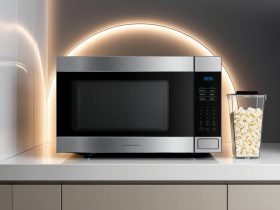
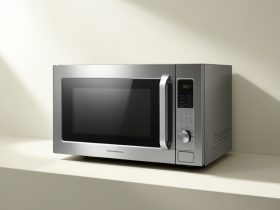
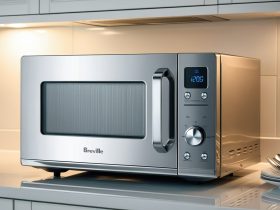


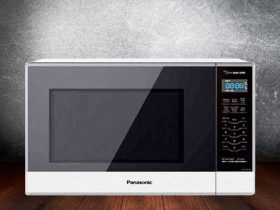
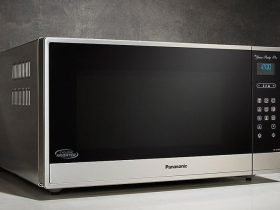
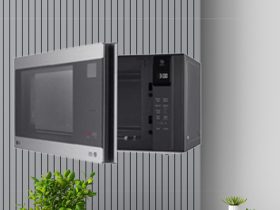



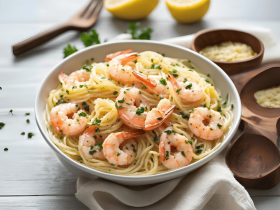




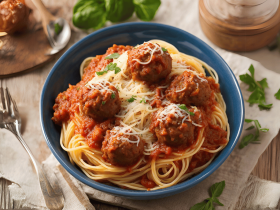
Leave a Reply